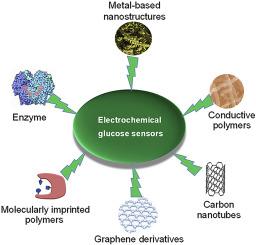当前位置:
X-MOL 学术
›
Biosens. Bioelectron.
›
论文详情
Our official English website, www.x-mol.net, welcomes your feedback! (Note: you will need to create a separate account there.)
Significance of nanomaterials in electrochemical glucose sensors: An updated review (2016-2020).
Biosensors and Bioelectronics ( IF 12.6 ) Pub Date : 2020-03-26 , DOI: 10.1016/j.bios.2020.112165 Ekin Sehit 1 , Zeynep Altintas 1
Biosensors and Bioelectronics ( IF 12.6 ) Pub Date : 2020-03-26 , DOI: 10.1016/j.bios.2020.112165 Ekin Sehit 1 , Zeynep Altintas 1
Affiliation

|
The last decade has witnessed an immense demand for the development of new glucose biosensors. The research has mainly focused on achieving biocompatible and improved sensing capabilities as compared to the current technologies, which opens new directions toward more efficient glucose sensors. These sensing platforms have been continuously evolving with the contribution of novel materials, such as gold, platinum, metal alloys/adatom, graphene, composites and glucose-specific organic materials, owing to their electrocatalytic response to the oxidation of glucose. The chief motive of this review is to cover the recent advances on enzymatic and non-enzymatic glucose sensors evolved in the last four years. We discuss the sensor fabrication methods, the materials and nanostructures involved, the detection principles and the performance of the sensors in whole blood, saliva, urine or interstitial fluids in detail.
中文翻译:

纳米材料在电化学葡萄糖传感器中的意义:最新评论(2016-2020年)。
过去十年见证了对新型葡萄糖生物传感器开发的巨大需求。与目前的技术相比,该研究主要集中在实现生物相容性和改进的传感能力上,这为朝着更高效的葡萄糖传感器开辟了新的方向。由于它们对葡萄糖氧化的电催化响应,这些传感平台一直在不断发展,例如金,铂,金属合金/吸附原子,石墨烯,复合材料和葡萄糖特定的有机材料等新型材料。这篇综述的主要目的是介绍近四年来酶和非酶葡萄糖传感器的最新进展。我们讨论了传感器的制造方法,涉及的材料和纳米结构,
更新日期:2020-04-20
中文翻译:

纳米材料在电化学葡萄糖传感器中的意义:最新评论(2016-2020年)。
过去十年见证了对新型葡萄糖生物传感器开发的巨大需求。与目前的技术相比,该研究主要集中在实现生物相容性和改进的传感能力上,这为朝着更高效的葡萄糖传感器开辟了新的方向。由于它们对葡萄糖氧化的电催化响应,这些传感平台一直在不断发展,例如金,铂,金属合金/吸附原子,石墨烯,复合材料和葡萄糖特定的有机材料等新型材料。这篇综述的主要目的是介绍近四年来酶和非酶葡萄糖传感器的最新进展。我们讨论了传感器的制造方法,涉及的材料和纳米结构,



























 京公网安备 11010802027423号
京公网安备 11010802027423号